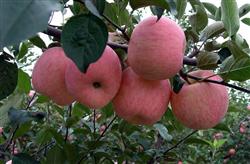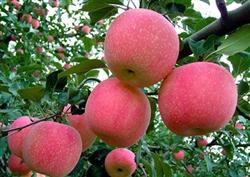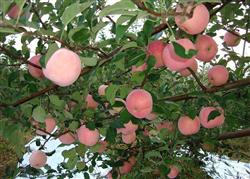Red Fuji apple why rotten fruit

Why are red Fuji apples rotten? Please introduce in detail that red Fuji rotten fruit is caused by a variety of reasons, find the reasons for comprehensive prevention and control can see the effect. First, the cause of rotten fruit 1. The ring is too much and too heavy. Most fruit growers mistakenly believe that red Fuji apples can not achieve the goal of flower formation without girdling, and will not be able to produce high yields in the coming year, so they peel (cut) the trees many times in successive years. After girdling at the base of the trunk, some are also girdled on the main branches and auxiliary branches, coupled with not adding organic fertilizer, not paying attention to formula fertilization, partial application of nitrogen fertilizer, hanging too much fruit and other reasons, resulting in excessive weakness of the tree, causing opportunities for bacteria. According to the survey, the rotten fruit of weak trees is as much as 40% to 60%, while the managed orchards of strong trees are only 5% and 10%. two。 Pay more attention to treatment than prevention. It is mainly unable to grasp the critical period of prevention and control, because the rotten fruit disease is infected in the early stage of fruit growth, that is, before the wheat harvest, the disease is serious when it is near maturity, and there is a relatively long incubation period, many fruit growers mistakenly focus on the later stage of prevention and control, while ignoring the prevention in the early stage. 3. The disease source of postharvest apple is not completely eliminated. Some fruit growers did not remove diseased branches, tumors, diseased fruits, stiff fruits and other bacterial sources in time, diseased fruits and diseased branches were thrown randomly, did not be buried deeply or taken out of the garden for centralized treatment, and even used diseased branches as open-angle scaffolds. 4. The spray quality is poor. The bacteria that cause rotten fruit are mainly invaded by lenticels, wounds, etc., if the fruit surface can not be evenly coated with medicine, it will leave the bacteria a chance of infection. At present, most orchards have the phenomenon of large number of branches and closed between plants and rows, so it is difficult to guarantee the spray quality. Second, comprehensive prevention and control measures. Clean up the orchard thoroughly. After the fruit is harvested, the fallen leaves, weeds and rotten fruits in the orchard are thoroughly removed and burned, or buried in the fertilization ditch when combined with basal fertilizer. Cut off the disease and insect branches, broken branches and dry and withered branches, take them out of the garden and burn them. Never use the branches of a diseased tree as an open-angle support. Dead branches, dead piles and Robinia pseudoacacia are not used as protective walls to reduce the source of bacteria. two。 In addition to curing rot. For fruit trees with rot disease, scrape off the warped skin and rough skin on the branches during the dormant period, and immediately apply 100 times liquid thiram + 2% Pingjia or Topurazine oil (70% methyl topiramate 1 part + soybean oil or other vegetable oil 15 parts). When the disease is mild, scrape off the disease spot in time, and then disinfect it with 5 Bomedo stone sulfur mixture, which can prevent the disease spot from expanding and spreading. In a seriously diseased garden or tree, after scraping off the disease spot, the trunk and branches of the tree were smeared with 100-fold solution of Fumei arsenic or mixed with 200-fold sodium pentachlorophenol before germination. Re-scrape the skin during the growing season to scrape off the diseased tissue and reduce the source of bacteria. 3. Spray to prevent diseases and insects. Spraying barium polysulfide 50-80-fold solution or 3-pomethyl sulfide mixture plus 200-fold pentachlorophenol sodium immediately after scraping and cleaning the garden and before germination has a certain control effect on scale insects, red spiders, apple powdery mildew and early deciduous leaf disease, especially wheel streak and anthracnose. Serious rotten orchards after defoliation and before germination spray 40% Fumei arsenic 100 times or 50 times of Fumiqing. During the growing period, the diseased fruit should be removed in time, cleaned up, taken out of the garden and buried deeply, and must not be thrown at random. From about 10 days after the apple blossoms to the near ripening period of the fruit, the pathogen can infect the fruit continuously and cause the fruit to carry bacteria. This period is roughly from the first and middle of May to the first and middle of August, and the infection period is as long as 3 months. During this period, it is necessary to spray once every 10-15 days to protect the fruit and prevent infection, so as to reduce the fruit carrier and the incidence of disease. The arrangement of the spraying period must be closely related to the rainfall, adhere to the principle of "spraying after rain", spray more rain, spray less rain, spray regularly without rain, and spray every rain outside the effective period. 4. Strengthen the cultivation management and improve the disease resistance of trees. Virus-free seedlings should be selected when new orchards are built, and diseased plants should be eradicated in time. The fruit trees should be fertilized and irrigated reasonably, the combined application of nitrogen, phosphorus and potassium should be strengthened, and no partial application of nitrogen fertilizer should be applied. Generally speaking, 0.7 kg of pure nitrogen, 0.3 kg of pure phosphorus and 0.7 kg of pure potassium are needed for every 100 kg of high-quality fruit. Organic fertilizer should be applied according to the proportion of 1.5-2kg fertilizer for every 1kg of high-quality fruit produced. Click to get more apple tree planting techniques click to get more fruit planting techniques
- Prev

Red Fuji apple how to color
How does red Fuji apple add color? Please introduce that when the fruit is colored on the sunny side, the leaves that affect the fruit coloring should be removed in time. For the uncolored side of the fruit or the butt joint of two fruits, it should be twisted to the sunny side in due course. Fruit growth late should be timely erect props and hanging branches, to prevent the fruit due to branch...
- Next

How to manage red Fuji apple fat water
How to manage red Fuji apple fat water? Please guide the red Fuji orchard, generally in late September to apply the best base fertilizer, mainly soil fertilizer, yield 2000 kg per mu below the young orchard to kg fruit 2~3 kg fertilizer, yield 2000~3000 kg per mu high-yield garden to kg fruit kg fertilizer, yield more than 3000 kg per mu...
Related
- Moge, come on! The staff of the peasant association in the producing area of cantaloupe were frightened when the crowd gathered.
- Causes and Solutions of low Fruit setting rate of Apple
- Symptoms and control measures of passion fruit virus disease
- Fruit growing lesson: how do apple orchards keep high yields?
- Can you build orchards in the mountains? What are the pros and cons?
- How to manage the coloring period of Crisson grape?
- This paper introduces the processing technology of two kinds of fig products.
- How much is a month for retired teachers in rural areas by 2020?
- How can strawberry planting increase sugar content? We should pay attention to management in many aspects.
- What are the cultivation techniques on how to improve the yield of golden fruit?

